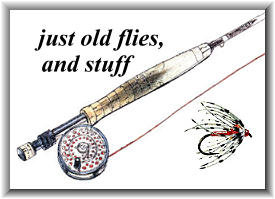With a classic Partridge-and-Orange adorning the top of
this column, it's probably appropriate to take a
look at soft-hackled wet flies and their use over the
years.
Soft-hackled wet flies, like their stiff-hackled cousins, the
Variants, are a type of fly, not a pattern. And they're a
very old type. It is said -- with some justification -- that
they may date back to the "donne flye" of Dame Juliana Berners
in A Treatise on Fyshing With an Angle, written
in 1496. Certainly they were in common use in Scotland in the
early 19th century, and probably before.
Soft-hackles have been a basic fly on Scottish streams for
two centuries or more for several reasons: They're easy to
tie, they're inexpensive, and they work. Also, they're
ideally suited to the swift-flowing streams of the Highlands.
Probably no fly is easier to tie than a soft-hackle. Wind a
hook with tying thread or floss; add a couple of twists of
partridge, grouse, woodcock or starling hackle; and you're
done. No tricky wings to set in place -- not even a tail.
Certainly they appealed to the legendary Scotch frugality.
Except for the hooks, there was just about no cost at all.
Leftover thread from the family sewing basket made up the
body; the hackles came from game birds shot for the pot.
Probably Scotland's leading practitioner of the art of the
soft-hackled fly in the early-to-mid 19th century was W.C.
Stewart, who published "The Practical Angler" in 1857. Stewart
devoted almost 70 pages of his book to his three famous
soft-hackled "spiders" -- the Black Spider, the Red Spider
and the Dun Spider. In each case, he named the fly by the
color of its hackle -- not its body (and indeed, for the
Dun Hackle, he listed no body at all).
Stewart's Black Spider consisted of nothing more than brown
tying silk on the shank of the hook and a purplish-black
starling feather palmered slightly toward the bend. The
Red Spider called for a slim body of primrose yellow tying
silk and the reddish feather from the wing of a land rail.
Stewart's recipe for the Dun Spider calls only for a dun
feather from a dotterel. (James E. Leisenring, the famous
wet-fly fisher of the Brodheads, apparently couldn't accept
the idea a hackle-only fly; in his 1941 classic, The Art
of Tying the Wet Fly, he specified a body of primrose
tying silk.)
Perhaps the most diligent proponent of soft-hackles in recent
years -- at least in the United States -- has been Sylvester
Nemes, in his book, The Soft-Hackled Fly. In
England, where they still call the flies "spider wets,"
Malcolm Greenhalgh has also sung their praises in print.
Whatever you call it, though, the fly has lasted through the
centuries for one simple reason: It works. The key is the soft
hackle. Like marabou, the soft feathers of gamebirds and
songbirds move seductively with the currents, whispering "I'm alive!
I'm alive!" And trout, smallmouth bass, panfish and probably a
host of other species heed that siren call.
One year, just for fun, I fished soft-hackles exclusively for an
entire trout season and saw no noticeable difference between my
take that season and my catch during seasons when I frantically
ran through a whole vest full of fly boxes trying to "match the
hatch."
Soft-hackles can be fished upstream or down. Stewart fished his
upstream; Nemes tends to favor a downstream approach. I do both.
Probably no fly -- with the possible exception of the Muddler
Minnow -- is more versatile. Soft-hackles can be tied on dry-fly
hooks and fished just below the surface; they can be tied on
wet-fly hooks and fished deeper, or they can be beadheaded and
fished near the bottom with a "Leisenring Lift." If you fish
them across-and-down, you can retrieve them with little jerks
to imitate miniature minnows. You can grease the leader to within
an inch or so of the fly and fish it as a spinner during a
spinner fall. Or you can grease the fly itself and fish it
as a dead or dying dun caught in the surface film.
My personal favorite for summer evenings (or mornings) here
in New England is the Partridge-and-Yellow. Close behind is
the Partridge-and-Orange. Here's the tie for the P&Y. Just
modify the color of the floss to change the pattern.
Partridge-and-Yellow
As tied by John W.P.Mooney
- Thread: Yellow.
- Body: Yellow floss.
- Hackle: About 2-1/2 turns of gray or
brown English partridge feather.
For the Partridge-and-Orange, I prefer a reddish-brown grouse
or woodcock feather; for the Partridge-and-Green, a gray English
partridge feather. ~ John W.P.Mooney
Credit: The photo is from
www.flytyingworld.com and was taken by Ed Gallop of a fly tied
by Ed Thomas.
|



